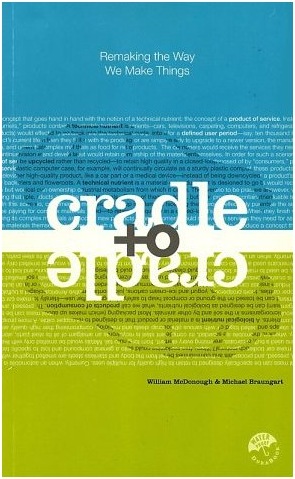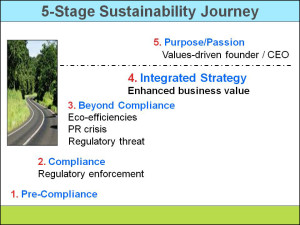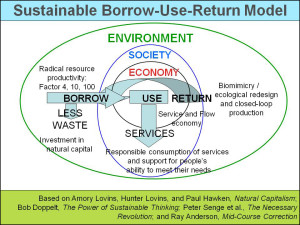5 Criteria for a Sustainable Business Model

It’s one thing to critically assess how today’s dominant business model is not sustainable; it’s another thing to design one that is. As sustainability champions, we need to have a positive vision of the pot of gold at end of the sustainability rainbow. We need to be able to respond to a “put up or shut up” challenge with a description of a sustainable business model that is better for the environment, society, and the company.
In my August 3, 2010 blog, I described four critical attributes of today’s way of doing business that make it unsustainable. We are facing serious constraints as we experience a rising demand from an exploding world population for increasingly scarce resources. Today’s linear take-make-waste business model is not designed to handle this reality. In fact, it is culpable for contributing to its unsustainability.
When guiding companies on their 5-stage sustainability journeys, we need to know where we are going—what a sustainable company in Stage 4 or 5 looks like. It behooves us to have a blueprint for a sustainable business, one that is simple enough that it is a handy guide to knowing when we’ve arrived at our destination.Here are five characteristics of a sustainable, cyclical, borrow-use-return business paradigm, overlaid on the 3-nested-dependencies model of a sustainable society, described in my July 20 blog.
1. Radical resource productivity
Companies stretch natural resources by increasing productivity for a given amount of a resource by factors of 5, 10, or even 100. They work to eliminate dependencies on materials and energy from resources dug from the earth’s crust. This commitment addresses issues of overharvesting and depletion of natural capital.
2. Investment in natural capital
Companies restore, maintain, and expand ecosystems to sustain society and business needs.
3. Ecological redesign
Companies use closed-loop production systems in which waste from production and end-of-life disposal is treated as a resource and reused, rather than sent to a landfill. Companies acknowledge they can’t throw things away because there is no “away.” They also work to eliminate man-made toxic chemicals from their production processes.
4. Service and flow economy
Companies replace their goods with services. They lease products and their solutions instead of selling them. When the product becomes obsolete or is unable to produce its service, the company takes it back and recycles or remanufactures the returned product.
5. Responsible consumption
Although it sounds like an oxymoron, responsible consumption reduces the demand for stuff and its associated pollution and waste, as graphically explained in The Story of Stuff. The company promotes responsible consumption by educating consumers so they can make more informed decisions about their purchases based on products’ location of origin, the labor conditions under which they were made, their ingredients, their packaging, their life-cycle ecological footprints, and other sustainability-related criteria. New forms of company ownership and profit sharing ensure company success is more equitably shared among employees and other stakeholders. The company avoids any inadvertent interference with people’s ability to meet their basic needs.
The sustainable borrow-use-return model enables companies to perform as described by William Donough and Michael Braungart in Cradle to Cradle.
- “Buildings that, like trees, produce more energy than they consume and purify their own waste water.
- “Factories that produce effluents that are drinking water.
- “Products that, when their useful life is over, do not become useless waste but can be tossed onto the ground to decompose and become food for plants and animals and nutrients for the soil; or, alternately, they can return to industrial cycles to supply high-quality raw materials for new products.
- “Billions, even trillions, of dollars’ worth of materials accrued for human and natural purposes each year.
- “Transportation that improve the quality of life while delivering goods and services.
- “A world of abundance, not one of limits, pollution, and waste.”

Isn’t that an exciting business model? You bet. And it is achievable. It is a win-win-win for the environment, society, and the company. Next week, we’ll look at four stepping stones that take companies from an unsustainable business model to this sustainable one.
Bob
Please feel free to add your comments and questions using the Comment link below.






Comments are closed.